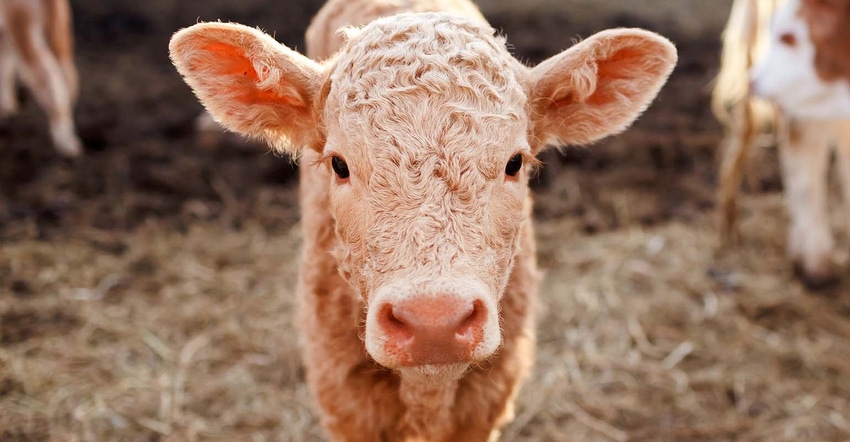Calf needs colostrum within first 24 hours after birth.
March 27, 2018

How do you prepare for spring calving?
"Weather during our Upper Midwest spring calving season can prove challenging with frigid temperatures and mud. When weather becomes a factor during calving, it can impact a calf's survival," said Taylor Grussing, SDSU Extension Cow/Calf Field Specialist.
Here’s some research-based tips and insight into calf health products to keep on hand.
Colostrum
Colostrum, the first milk a dam produces after calving, contains a high concentration of antibodies and immunoglobulins such as immunoglobulin G (IgG).
"In order for newborn calves to receive maximum benefit and passive immunity from colostrum, research shows the calf needs to receive it within the first 12 to 24 hours after birth," Grussing explained. "Antibodies are not transferred across the placenta during gestation."
It is recommended that beef calves receive 2 to 3 quarts of colostrum within the first 24 hours of life. But what options are available when this first milk is not available?
"If colostrum can be sourced from well-vaccinated, disease-free herd, it can be frozen in quart size freezer bags for future use," Grussing said.
To thaw frozen colostrum, take care to do it slowly by placing the bag in warm water of about 110 degrees Fahrenheit and stir every five minutes until the colostrum reaches a temperature of 104 to 110 degrees Fahrenheit.
Typically, this will take about 40 minutes.
Do not use a microwave oven as overheating proteins in the colostrum will cause them to denature and deliver little immunity to the newborn calf.
Commercial colostrum replacements can be purchased. Replacement products will have greater than 100 grams of IgG per dose.
Colostrum supplements are also available and will have 50 grams of IgG per dose.
How do producers decide between using a colostrum replacement versus a supplement?
If maternal colostrum is completely unavailable, a replacement product should be used. However, if some maternal colostrum is available to the newborn, but not the recommended 2 to 3 quarts, a colostrum supplement can help make up the difference.
Price is reflected in the different options as colostrum replacements provide more IgG and will be more expensive, but both will help ensure more successful passive transfer of immunity and nutrients to the calf during the first 24 hours of life.
Other products
Oral Calf Paste/Gel: Oral calf paste/gel products that come in 30 milliliter tubes have become popular in recent years as an easy way to provide additional nutrients to newborn calves. But do these pastes provide the same immunity as colostrum?
Calf pastes will vary in design to provide all or some of the following supplements: energy, vitamins, minerals, E.coli prevention, probiotics and lactic acid to name a few.
These pastes are not colostrum replacements or supplements. Therefore, it is important to not substitute one for the other based on calf needs.
"If a calf needs a small burst of energy on a cold day or appetite stimulation, these paste may be a convenient option for producers. Yet, long term benefits are not the goal of these products," Grussing said.
Electrolyte solutions
Electrolyte solutions should be used to provide fluid to calves that have scours.
Livestock producers should purchase electrolytes that also contain vitamins and minerals, especially sodium, potassium, chloride and bicarbonate.
When a calf has scours, livestock producers should give the calf a 2-quart dose of electrolyte fluid every two to six hours as needed.
"Electrolytes are not a complete nutrient replacer, some energy and protein supplements may be necessary if the calf is not nursing consistently," Grussing said. "As long as the calf is not in severe dehydration, nursing does not prolong or worsen diarrhea."
Keep in mind that the gut healing process is still taking place after scours have stopped; therefore, continued treatment is important for full recovery.
Source: SDSU Extension
You May Also Like



